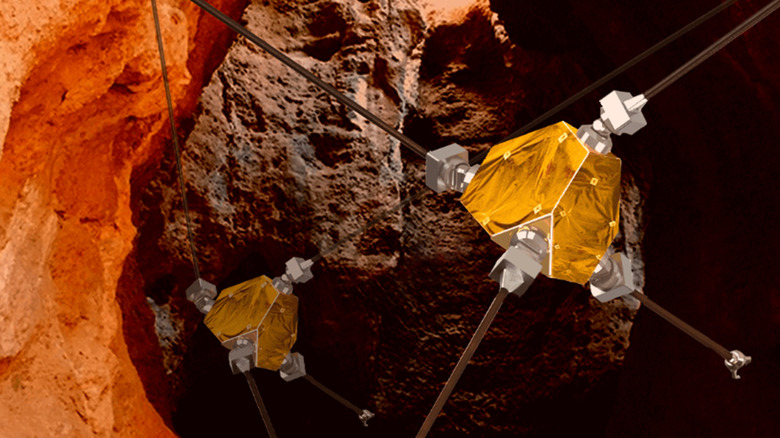NASA Is Training This Robot To Search Through Mars' Massive Cave Environments
NASA is no stranger to innovative robots, but the agency's new robotic cave explorer still manages to inspire a sense of awe. In cooperation with researchers at Stanford University, NASA is developing a small, lightweight robot that navigates around its environment using four long, retractable arms with grippers on the ends. The design allows the robot to be highly mobile without sacrificing its ability to manipulate the world around it. And, delightfully, they've named the new explorer ReachBot.
In its current form, ReachBot has a body section and four rotating joints spaced out evenly like the vertices of a tetrahedron. Retractable arms can extend straight out from each shoulder joint. These arms will likely be telescopic in the final version, but in the video shared by Stanford, the prototype uses tape measures to demonstrate the functionality. At the end of each of the arms is a gripping mechanism.
To explore Martian caves, ReachBot first anchors itself to the cave walls using three of its grippers. Then it extends the fourth arm out in the direction it wants to travel and grabs a surface. ReachBot can pull itself in this direction by shortening this arm, while also extending its other arms to simultaneously propel itself forward. Then the process repeats. ReachBot's construction can take advantage of Mars' lower gravity by using less material, because the forces pulling against ReachBot's motions will be reduced. It's a simple way to see inside Martian caves well before humans ever set foot on its regolith.
Why caves?
No one has ever explored the cave systems on Mars, so there's an element of the unknown to contend with in planning future missions. While it's much safer to send a robot in place of a human, it's still an immensely complex and expensive task. ReachBot's smaller size and weight can help reduce the overall mission cost, and its optimized mode of exploration can increase its odds of success. But why do we want to visit Martian caves to begin with?
Mars has long been a leading candidate for the search for evidence of current or past extraterrestrial life, but in its present state the planet isn't particularly inviting. It's frozen, and dry, and lacks anything like Earth's atmosphere and magnetic field, meaning its surface is unprotected from harsh cosmic radiation. It would be difficult for life — or even signs of life — to survive long on the planet's surface. It's possible, however, that caves could provide varying levels of protection from these hazards, making them excellent places to search for living organisms.
ReachBot's designers initially set their sights on the red planet, but the robot could potentially find other targets throughout the solar system. There's no shortage of planets, moons, and asteroids whose rocky makeup and low gravity could also be excellent exploration targets for ReachBot, including Earth's very own Moon. It could even be used to maintain the Lunar Gateway space station during periods when it's uncrewed. Good thing they didn't name it HAL.
